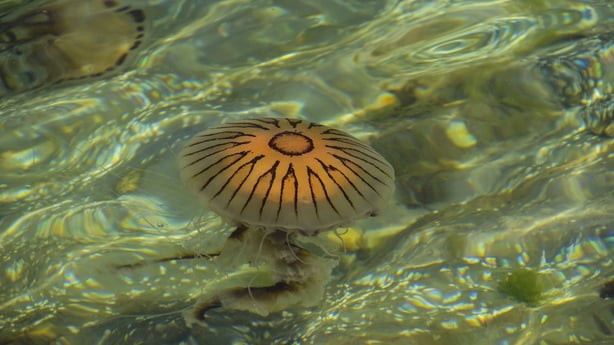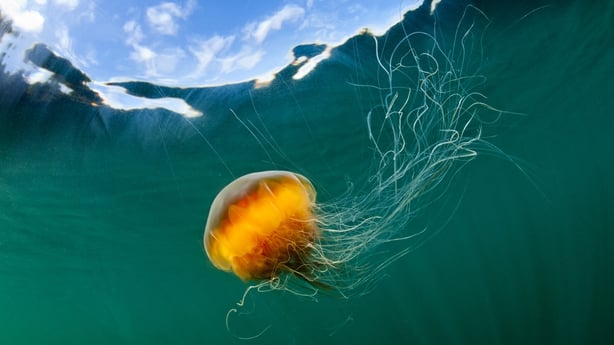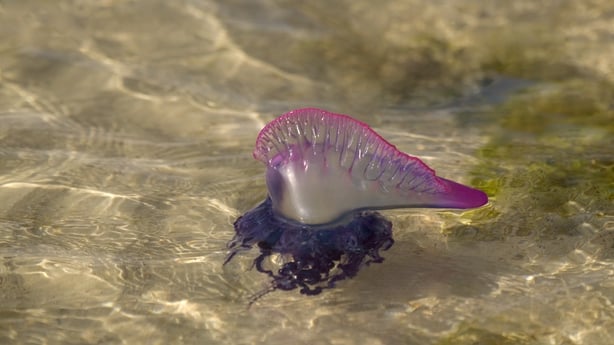Dr Ruth Freeman, Director of Science for Society at Science Foundation Ireland, joined Drivetime on RTÉ Radio 1 to discuss the variety of jellyfish in Ireland. Listen back above.
Thankfully, Irish waters are not home to the most dangerous jellyfish, as they tend to be happier in warmer and more tropical waters. However, there are five native jellyfish species in Ireland, and some of their stings may require some basic first aid.
The jellyfish species native to Ireland are:
- Barrel
- Blue
- Moon
- Compass
- Lion's Mane
Other jellyfish that may be spotted in Ireland:
- Pelagia noctiluca
- Portuguese Man O'War (not a true jellyfish but is closely related to the jellyfish family)

Which jellyfish do we have to worry about in Ireland?
"Really there are three common ones you need to look out for," says Dr Freeman, noting that the Portuguese Man O'War, although dangerous, are very rarely spotted in Irish waters.
"The Lion's Mane is the worst," she says, noting that they are easy to spot thanks to their long tentacles and yellow/red colouring.
Next up is the Compass jellyfish, which also has long tentacles but can be "hard to spot" as they are somewhat translucent.
The Blue jellyfish (also known as bluebottle) should also be watched out for as it will give you "a nettle-like sting".

According to the HSE, symptoms of a jellyfish stings may include:
- immediate stinging pain at the site of the sting
- skin reactions such as redness and itching which can start immediately after being stung or sometime after the sting
- severe pain
- long-lasting pain
- swelling of the affected area
- significant and long lasting skin reactions
A sting from a Lion's Mane jellyfish can cause nausea, sweating, cramps, headaches and other symptoms. Pelagia noctiluca stings can cause dizziness, vomiting, diarrhoea, difficulty breathing and other symptoms. Portuguese Man O'War can cause symptoms such as muscle spasms, headaches, diarrhoea, difficulty breathing, heart rhythm problems and other symptoms.
Unfortunately, it can be difficult to know what type of jellyfish you have been stung by, so Dr Freeman advises seeking medical attention if your discomfort goes above a nettle sting.
"If you have anything where you can't bear the pain, or there's a lot of swelling, or a lot of itching, or in fact if you're not feeling well in any other way because there is venom going into your system," she explains, noting that any breathing issues should receive medical attention.

What to do if you have been stung
- Seek help and advice from lifeguards if possible
- Remove yourself from the water
- Try to carefully remove any attached tentacles by flushing the sting area with sea water
- Removing tentacles with gloved hands, a clean stick, tweezers, or scraping gently with the edge of a credit card. Don’t try to rub them off.
- Mild symptoms of pain and swelling can be treated with simple painkillers
- Mild itching at the sting site may respond to anti-histamine creams
- Apply a 'dry cold pack' to the area
- Use hot water for Portuguese Man O'War stings at approximately 45° Celsius for 20 minutes
- Keep any puncture wounds clean and dry to avoid them getting infected
- Seek medical attention if you develop any serious symptoms
What not to do
- Don’t rub the area
- Don’t rinse with fresh water, use seawater
- Don’t pee on the sting (this is a myth and will make it worse)
- Don’t use vinegar for the types of jellyfish stings that might happen in Ireland
- Don’t use alcohol
- Don’t put on a tight bandage
For more information on jellyfish stings, visit HSE.ie.

